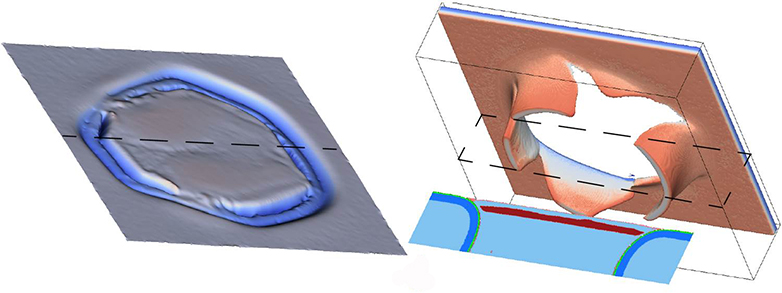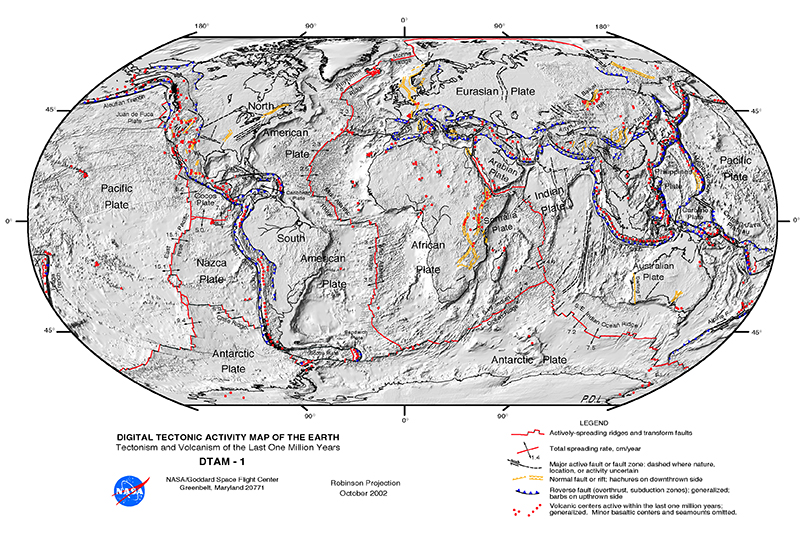What set the earth’s plate tectonics into motion?

This article is published in collaboration with ETH Zurich.
“Knowing what a chicken looks like and what all the chickens before it looked like doesn’t help us to understand the egg,” says Taras Gerya. The ETH Professor of Geophysics uses this metaphor to address plate tectonics and the early history of the Earth. The Earth’s lithosphere is divided into several plates that are in constant motion, and today’s geologists have a good understanding of what drives these plate movements: heavier ocean plates are submerged beneath lighter continental plates along what are known as subduction zones. Once the movement has begun, it is perpetuated due to the weight of the dense subducting plate.
But just as in the past, earth scientists still do not understand what triggered plate tectonics in the first place, nor how the first subduction zone was formed. A weak spot in the Earth’s lithosphere was necessary in order for parts of the Earth’s crust to begin their descent into the Earth’s mantle. Was this weak spot caused by a gigantic meteorite that effectively smashed a hole in the Earth’s lithosphere? Or did mantle convection forces shatter the lithosphere into moving parts?
Venus as a model
Gerya is not satisfied with any of these potential explanations. “It’s not trivial to draw conclusions about what set the tectonic movements in motion,” he says. The ETH professor therefore set out to find a new, plausible explanation.
Among other things, he found inspiration in studies about the surface of the planet Venus, which has never had plate tectonics. Gerya observed (and modelled) huge, crater-like circles (coronae) on Venus that may also have existed on the Earth’s surface in the early period (Precambrian) of the Earth’s history before plate tectonics even began. These structures could indicate that mantle plumes once rose from Venus’ iron core to the outer layer, thus softening and weakening the planet’s surface. Plumes form in the deep interior of the planet. They rise up to the lithosphere, bringing with them hot partially molten mantle material that causes the lithosphere to weaken and deform. Halted by the resistance of the hard lithosphere, the material begins to spread, taking on a mushroom-like shape.
Such plumes also likely existed in the Earth’s interior and could have created the weaknesses in the Earth’s lithosphere needed to initiate plate tectonics on Earth.
Mantle plumes create weaknesses
The ETH geophysicist worked with his team to develop new computer models that he then used to investigate this idea for the first time in high resolution and in 3D. The corresponding publication has recently been published in Nature.
The simulations show that mantle plumes and the weaknesses they create could have actually initiated the first subduction zones.

In the model, a mantle plume initially forms a weak point in the Earth’s crust. The circular structure (l.) bulges outwards, spreads through a constant supply of material from deep inside the planet and finally breaks down. At the edges, the crust plunges into the mantle (r.) and sets the tectonics in motion. (Illustration: from Gerya et al, Nature, 2015)
In the simulations, the plume weakens the overlying lithosphere and forms a circular, thinning weak point with a diameter of several dozen to hundreds of kilometres. This is stretched over time by the supply of hot material from the deep mantle. “In order to make a ring larger, you have to break it,” explains the researcher. This also applies to the Earth’s surface: the ring-shaped weaknesses can (in the model) only be enlarged and subducted if the margins are torn.
Water lubricates the plate margin
The tears spread throughout the lithosphere, large slabs of the heavier rigid lithosphere plunge into the soft mantle, and the first plate margins emerge. The tension created by the plunging slabs ultimately sets the plates in motion. They plunge, well lubricated by the buried seawater of the ocean above. Subduction has begun – and with it, plate tectonics. “Water acts as a lubricant and is an absolute necessity in the initiation of a self-sustaining subduction,” says Gerya.
In their simulations, the researchers compare different temperature conditions and lithosphere states. They came to the conclusion that plume-induced plate tectonics could plausibly develop under the conditions that prevailed in the Precambrian around three billion years ago. Back then the Earth’s lithosphere was already thick and cool, but the mantle was still very hot, providing enough energy to significantly weaken the lithosphere above the plumes.
Had the lithosphere instead being thin and warm, and therefore soft, the simulations show that a ring-shaped rapidly descending structure called drip would simply have formed around the plume head. While this would have steadily sunk into the mantle, it would not have caused the soft lithosphere to subduct and tear and therefore would not have produced plate margins. Likewise, the computer simulations showed that under today’s conditions, where there is less temperature difference between lithosphere and plume material, plume-induced subduction is hard to initiate because the lithosphere is already too rigid and the plumes are barely able to weaken it sufficiently.
Dominant mechanism
“Our new models explain how plate tectonics came about,” says the geophysicist. Plume activity was enough to give rise to today’s plate mosaic. He calls the power of the plumes the dominant trigger for global plate tectonics.
The simulations can also explain how so-called triple junctions, i.e. zones in which three plates come together, are nucleated by multi-directional stretching of the lithosphere induced by plumes. One such example of a triple junction can be found in the Horn of Africa where Ethiopia, Eritrea and Djibouti meet.
A possible plume-weakened zone analogous to a starting point for global plate tectonics likely exists in the modern world: the researchers see such a zone in the Caribbean plate. Its shape, location and spread correspond largely to the new model simulations.
Indeed it is arguably impossible to prove how global plate tectonics started on Earth based solely on observations: there is no geophysical and only a small amount of geological data from the Earth’s early years, and laboratory experiments are not possible for extremely large-scale and very long-term tectonic processes, says the ETH researcher. “Computer models are therefore the only way we can reproduce and understand the events of the Earth’s early history.”
Reference
Gerya TV, Stern RJ, Baes M, Sobolev S, Whattam SA. Plate tectonics on the Earth triggered by plume-induced subduction initiation. Nature, published online 11th November 2015, doi:10.1038/nature15752
Publication does not imply endorsement of views by the World Economic Forum.
To keep up with the Agenda subscribe to our weekly newsletter.
Author: Peter Rüegg studied Biology at ETH Zurich with focus on Ecology, Phytogeography and Biosystematics and is now working in the News & Media Relations team at ETH.
Image: Lava explodes from a volcano next to the village of Portela on Fogo Island. Picture taken November 28 2014. REUTERS/Saulo Montrond.
Don't miss any update on this topic
Create a free account and access your personalized content collection with our latest publications and analyses.
License and Republishing
World Economic Forum articles may be republished in accordance with the Creative Commons Attribution-NonCommercial-NoDerivatives 4.0 International Public License, and in accordance with our Terms of Use.
The views expressed in this article are those of the author alone and not the World Economic Forum.
Forum Stories newsletter
Bringing you weekly curated insights and analysis on the global issues that matter.
More on Nature and BiodiversitySee all
Tom Elliott and Tainah Godoy
April 3, 2025
Sophia Otoo and Cynthia Rayner
April 2, 2025
Nunzio Peleggi
March 28, 2025
Jack Hurd
March 27, 2025
David Elliott
March 25, 2025







